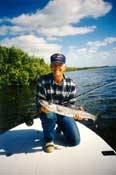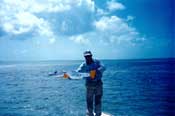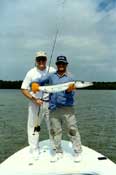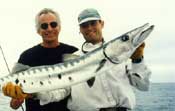Spooky Barracudas

By Capt. Tom Roland
 The
defining element of winter flyfishing in the Florida Keys and elsewhere are the
cold fronts. As the wind increases and the water temperature decreases, bonefish,
tarpon, and permit sometimes leave the flats for more consistent temperatures
found in deeper water. Redfin Needlefish and scores of baitfish remain on the
flat and offer a succulent feast for opportunistic barracudas gathering on the
flats. With the reputation of the barracuda as a voracious and aggressive predator,
many anglers pursue them with lofty expectations. Truthfully, big barracuda in
shallow water can be very difficult to catch. The
defining element of winter flyfishing in the Florida Keys and elsewhere are the
cold fronts. As the wind increases and the water temperature decreases, bonefish,
tarpon, and permit sometimes leave the flats for more consistent temperatures
found in deeper water. Redfin Needlefish and scores of baitfish remain on the
flat and offer a succulent feast for opportunistic barracudas gathering on the
flats. With the reputation of the barracuda as a voracious and aggressive predator,
many anglers pursue them with lofty expectations. Truthfully, big barracuda in
shallow water can be very difficult to catch.
Big barracuda lay motionless in strategic locations waiting for passing baitfish.
With their extraordinary eyesight, barracudas are able to spot their quarry from
great distances. Because barracuda constantly look upwards and outwards to spot
their prey, they become aware of a flats skiff advancing from a long way away.
Contrary to tarpon, bonefish and permit, when a barracuda sees the boat they do
not usually leave the flat but tolerate our presence and simply refuse to eat.
If the barracuda does not see the boat or the fly line in the air, the angler
stands a reasonable chance of catching the fish.
 To
entice an outsized barracuda to eat a fly, anglers need to cast long distances.
In fact, casts to wary barracuda need to be quite a bit longer on average than
most bonefish or even permit opportunities. Spin fishermen have phenomenal success
with barracudas simply because they can throw a very lifelike lure 150 feet or
more and rip it across the surface at 20 mph mimicking a fleeing needlefish or
houndfish. Barracuda enjoy the chase as much as the reward and often follow for
100 feet or more. Fly anglers can not imitate that action very well, but flyfishing
methods are very productive in their own way. I try to spot the fish from at least
100 feet away and set up the first shot at 70-80 feet. If my angler can get the
fly to the fish at this distance, chances for hookup rise dramatically. Present
the fly so that it lands well in front and beyond the barracuda so that it will
travel away from the fish. Throwing the fly across the fish's field of vision
allows it to get a good look at the fly with both eyes. I have found that barracudas
tend to initiate the pursuit more often if the fly is presented in this manner.
Begin stripping and twitching the fly slowly to get the fish's attention. As the
race begins, speed up the retrieve by stripping faster and longer. Continue stripping
fast and let the fish come up right behind the fly. Do not slow your retrieve.
If the barracuda does not eat the fly at this point, continue stripping quickly
until the fly is 30-40 feet from the boat and then sweep the rod tip through the
water while extending your arm to the side, bringing the fly right to your feet.
Barracuda are reluctant to eat flies if they have become aware of the boat. However,
if a barracuda focuses his attention on a fly before he sees the boat he will
track the fly within inches of it. Often the barracuda feels as though the fly
will escape underneath the obstruction (the boat) initiating the strike. If the
skiff comes too close to the barracuda before the cast is made, the fish becomes
aware of the boat and becomes agitated. Anglers can witness the fish turn away
from the boat or slowly move away. The ideal shot is to the single fish facing
the boat. Sometimes the fish are aggressive towards all flies thrown in their
direction but because of weather conditions and the general mood of the fish,
even long casts will not convince them to eat the fly. To
entice an outsized barracuda to eat a fly, anglers need to cast long distances.
In fact, casts to wary barracuda need to be quite a bit longer on average than
most bonefish or even permit opportunities. Spin fishermen have phenomenal success
with barracudas simply because they can throw a very lifelike lure 150 feet or
more and rip it across the surface at 20 mph mimicking a fleeing needlefish or
houndfish. Barracuda enjoy the chase as much as the reward and often follow for
100 feet or more. Fly anglers can not imitate that action very well, but flyfishing
methods are very productive in their own way. I try to spot the fish from at least
100 feet away and set up the first shot at 70-80 feet. If my angler can get the
fly to the fish at this distance, chances for hookup rise dramatically. Present
the fly so that it lands well in front and beyond the barracuda so that it will
travel away from the fish. Throwing the fly across the fish's field of vision
allows it to get a good look at the fly with both eyes. I have found that barracudas
tend to initiate the pursuit more often if the fly is presented in this manner.
Begin stripping and twitching the fly slowly to get the fish's attention. As the
race begins, speed up the retrieve by stripping faster and longer. Continue stripping
fast and let the fish come up right behind the fly. Do not slow your retrieve.
If the barracuda does not eat the fly at this point, continue stripping quickly
until the fly is 30-40 feet from the boat and then sweep the rod tip through the
water while extending your arm to the side, bringing the fly right to your feet.
Barracuda are reluctant to eat flies if they have become aware of the boat. However,
if a barracuda focuses his attention on a fly before he sees the boat he will
track the fly within inches of it. Often the barracuda feels as though the fly
will escape underneath the obstruction (the boat) initiating the strike. If the
skiff comes too close to the barracuda before the cast is made, the fish becomes
aware of the boat and becomes agitated. Anglers can witness the fish turn away
from the boat or slowly move away. The ideal shot is to the single fish facing
the boat. Sometimes the fish are aggressive towards all flies thrown in their
direction but because of weather conditions and the general mood of the fish,
even long casts will not convince them to eat the fly.
 In
the case of spooky barracuda, anglers can change their terminal tackle to accommodate
the situation. I routinely use a 12 foot tapered leader made of hard monofiliment.
I use a standard bonefish or permit taper for my leader construction and usually
taper to 12-pound test. The butt section is connected to the fly line with a nail
knot with a lock. The taper is created with blood knots throughout the leader.
Barracuda have a mouth full of razor sharp teeth that are not only sharp on the
point but also on the sides like a double-edged knife. These teeth will shear
any monofiliment and the only material that will stand up to the task is wire.
Choices in wire are varied but the basic types are solid or braided. I have come
to prefer the solid wire for barracudas and I only use a 3-6 inch shock tippet
comprised of 30-pound wire. I connect the wire to the leader using an Albright
knot and attach the fly with a Haywire twist. The shorter shock tippet may result
in a few fish biting through the class tippet but I have found that I can get
a much larger number of fish to bite the fly. In
the case of spooky barracuda, anglers can change their terminal tackle to accommodate
the situation. I routinely use a 12 foot tapered leader made of hard monofiliment.
I use a standard bonefish or permit taper for my leader construction and usually
taper to 12-pound test. The butt section is connected to the fly line with a nail
knot with a lock. The taper is created with blood knots throughout the leader.
Barracuda have a mouth full of razor sharp teeth that are not only sharp on the
point but also on the sides like a double-edged knife. These teeth will shear
any monofiliment and the only material that will stand up to the task is wire.
Choices in wire are varied but the basic types are solid or braided. I have come
to prefer the solid wire for barracudas and I only use a 3-6 inch shock tippet
comprised of 30-pound wire. I connect the wire to the leader using an Albright
knot and attach the fly with a Haywire twist. The shorter shock tippet may result
in a few fish biting through the class tippet but I have found that I can get
a much larger number of fish to bite the fly.
I am careful to use lines that are camouflage in some way. A few years ago
I began fishing with the clear fly lines on the market. I have had great success
with both the floating and the sinking clear fly lines. There have been numerous
and varied fish caught on my boat with clear lines that would have been spooked
with a brightly colored line. Clear lines are wonderful for barracuda and highly
suggested. I also dye my standard lines for all species. The colors that I have
found least offensive to permit, tarpon, bonefish, and barracuda are olive, black,
dark green, and brown. I use rit dye or waterproof markers to color the lines
permanently. These colored lines resemble the natural vegetation in the water
and have proven to spook fewer fish. For barracudas I prefer a clear line for
the best and most stealthy presentation.
 In
many situations, barracuda are in very shallow water. Large and heavy flies will
often spook them upon entry. Big barracuda will eat very small flies and sometimes
prefer them. Try using small flies that enter the water without a splash. Using
small flies for big barracuda is my favorite. Watching a cuda chase down a fly
that he thinks is a real fish and not simply aggravating the fish into striking
is one of the great joys of flyfishing. Conversely, big flies can be the only
things that can convince a big cuda to eat. Flies 12 inches and larger are excellent
patterns to throw at cudas. I use extra large flies on tough fish in deeper water.
I carry a wide variety of flies in many sizes, sink rates, colors and shapes that
I use on a regular basis. Whether I am using the extra large or the small flies,
I have found that barracuda will often short-strike. I have begun tying tube flies
for a few reasons. First, tube flies enable the tyer to create flies of any size.
Secondly, the tyer can place the hook anywhere within the fly. I choose to locate
the hook even further back than the end of the fly. Simply include a piece of
aquarium tubing between the tube fly and the hook the length that you require.
Also, try different patterns than the normal baitfish patterns. Some very large
barracuda have been caught on bonefish or permit flies. In
many situations, barracuda are in very shallow water. Large and heavy flies will
often spook them upon entry. Big barracuda will eat very small flies and sometimes
prefer them. Try using small flies that enter the water without a splash. Using
small flies for big barracuda is my favorite. Watching a cuda chase down a fly
that he thinks is a real fish and not simply aggravating the fish into striking
is one of the great joys of flyfishing. Conversely, big flies can be the only
things that can convince a big cuda to eat. Flies 12 inches and larger are excellent
patterns to throw at cudas. I use extra large flies on tough fish in deeper water.
I carry a wide variety of flies in many sizes, sink rates, colors and shapes that
I use on a regular basis. Whether I am using the extra large or the small flies,
I have found that barracuda will often short-strike. I have begun tying tube flies
for a few reasons. First, tube flies enable the tyer to create flies of any size.
Secondly, the tyer can place the hook anywhere within the fly. I choose to locate
the hook even further back than the end of the fly. Simply include a piece of
aquarium tubing between the tube fly and the hook the length that you require.
Also, try different patterns than the normal baitfish patterns. Some very large
barracuda have been caught on bonefish or permit flies.
If the barracuda are simply too spooky to approach in the boat, wade if you
dare. Wading can put you within casting range of barracuda that see the boat from
great distances. Be careful for both the barracuda and more importantly, the sharks.
Huge blacktips, lemons and bull sharks are on the flats specifically to eat barracudas.
Use extreme caution when releasing barracuda as a big shark will literally stop
at nothing to eat a barracuda.
When fishing for barracudas, always carry a pair of gloves and an extra long
pair of pliers. The best I have found are "Hookouts". These pliers will
keep the barracuda from biting your fingers. Handle barracuda gently but firmly.
Always point their head towards the water with no obstruction in the way. If the
barracuda lunges or squirms out of your hands, simply toss it in the water. A
loose barracuda in the boat can do great damage to passengers and to the boat.
Even though barracudas are supreme predators that attack every chance they
get, most days prove that they are also wary and reluctant to eat flies. By changing
your tactics slightly and using these techniques, fish that were previously spooked
by the boat may now be caught.
Click on any of the above photos for larger version,
remember to use your browser's back button to return.
|
 |
 |
|
 Capt.
Tom Rowland is located in Key West, Florida where he operates Big Blue Flyfishing,
Inc. He fishes the flats from the Marquesas Keys (25 Miles west of Key West) to
Islamorada for Tarpon Permit, Bonefish and a few other species of fish. This area
provides some of the worlds finest shallow water sight fishing and wildlife/bird
watching. Capt.
Tom Rowland is located in Key West, Florida where he operates Big Blue Flyfishing,
Inc. He fishes the flats from the Marquesas Keys (25 Miles west of Key West) to
Islamorada for Tarpon Permit, Bonefish and a few other species of fish. This area
provides some of the worlds finest shallow water sight fishing and wildlife/bird
watching.
Tom is a fly fishing specialist of the highest caliber. His flats boat is a
1997 Maverick Mirage HP loaded with Scott Rods, Abel Reels, Seamaster Reels and
Scientific Anglers lines, and his personal casting and fishing skills are unsurpassed
by any guide or angler.
He is sponsored by Scott Fly Rods, Yamaha, and Oakley Sunglasses, and recently
won the Flyfishing division of the ESPN Great Outdoor Games.
Contact Information
PO Box 701
Key West, FL 33041
305-294-7447
[email protected]
Web Site Link
|
|
 |
 |
|

